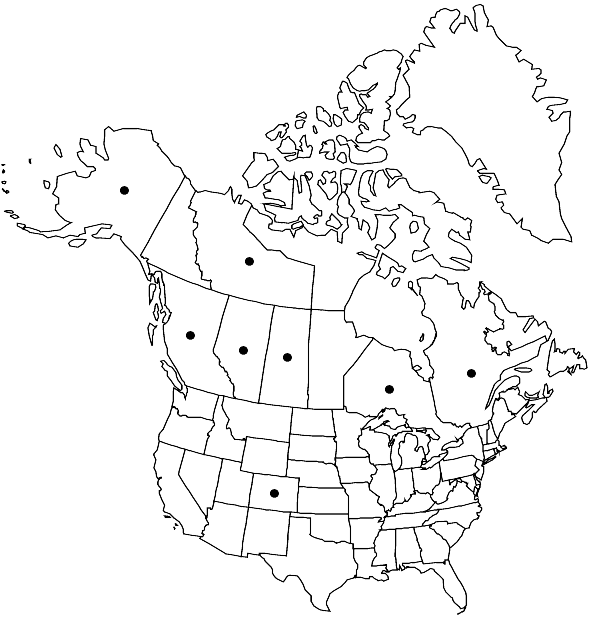Schistidium boreale
Svensk Bot. Tidskr. 47: 256, fig. 1b, e. 1953,.
Plants in open tufts or mats, dull black, often yellowish green distally, usually purplish when wet, especially in older portions of stems. Stems 1.5–10 cm, central strand absent or indistinct. Leaves erect proximally, usually slightly curved distally, rarely somewhat secund when dry, ovate-lanceolate, sharply keeled distally, 1.6–2.5 mm, 1-stratose; margins usually recurved throughout, denticulate distally, 1- or 2-stratose; apices acute; costa percurrent or excurrent as a denticulate, occasionally weakly decurrent awn, abaxial surface papillose; basal marginal cells quadrate or oblate, often trigonous; distal laminal cells mostly short-rectangular or quadrate, 8–10 µm wide, papillose, strongly sinuose with reddish or orange walls. Sexual condition autoicous. Capsule red-brown, sometimes orange-brown, ovoid-cylindric, narrowed to the mouth, 0.7–1.25 mm, rarely striate when old; exothecial cells mostly isodiametric, mainly more or less quadrate, usually mixed with a few short-elongate or oblate cells, thin-walled, with small trigones; stomata present; peristome patent or erect, dark-red or red, 190–380 µm, densely papillose, entire or slightly perforated. Spores 10–14 µm, granulose.
Phenology: Capsules mature late spring to early summer.
Habitat: Somewhat shaded granite or limestone ledges
Elevation: low to high elevations (0-2000 m)
Distribution

Alta., B.C., N.W.T., Ont., Que., Sask., Alaska, Colo., Eurasia.
Discussion
Schistidium boreale is one of the five species of the genus in North America with papillose distal laminal cells. The combination of its dull black color, usually turning purplish when wet, reddish or orange laminal cell walls, and ovoid-cylindrical capsules that are narrowed at the mouth separates this species from the other papillose taxa. Schistidium papillosum is usually olivaceous and lacks colored cell walls; S. strictum is usually a dull red-brown, has cupulate capsules, and appears to be restricted to northwestern, coastal areas, and S. frisvollianum, an arctic species, is more strongly ornamented. None of these three taxa turns purple when wet. Schistidium maritimum occasionally has papillose distal laminal cells. That species, however, is restricted to coastal areas, its leaves are ovate-lanceolate to linear-lanceolate with 2-stratose distal laminae, and its costa has one or two well-developed stereid bands, which are absent in all other North American species of the genus.
Selected References
None.